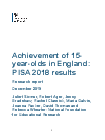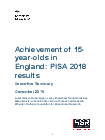Education disrupted – education rebuilt: Some insights from PISA on the availability and use of digital tools for learning

As school after school shuts down in the face of the COVID-19 crisis (now in more than 150 countries), online learning opportunities have risen from a nice-to-have extracurricular facility to become the lifeline for education.
The opportunities that digital technologies offer go well beyond a stop-gap solution during the crisis. Digital technology allows us to find entirely new answers to what people learn, how people learn, where people learn and when they learn.
That being said, the COVID-19 crisis strikes at a point when most of the education systems covered by the OECD’s latest round of the Programme for International Student Assessment (PISA) are not ready for the world of digital learning opportunities.
Below are some sobering numbers. The data were collected as part of the global PISA assessment in 2018, and are based on representative samples from 79 education systems involving over 600 000 15-year-olds.
Students’ access to the digital world
Starting with the very basics, on average across OECD countries, 9% of 15-year-old students do not even have a quiet place to study in their homes, and in Indonesia, the Philippines and Thailand it is over 30%. This is not a random group, but it tends to be students from the most disadvantaged backgrounds. Even in PISA top-performer Korea, one in five students from the quarter of the most socio-economically disadvantaged schools do not have a place to study at home.
A quiet place to study is a good start, but an obvious prerequisite to online learning is having access to a computer that students can use to do their work in their homes. In Austria, Denmark, Iceland, Lithuania, the Netherlands, Norway, Poland, Slovenia and Switzerland, over 95% of students report that they have a computer to use for working at home, but in Indonesia, it is only 34%. Here, too, there tend to be very large gaps across socio-economic groups. For example, virtually every 15-year-old in socio-economically advantaged schools in the United States has a computer to work with at home, but only three out of four students in disadvantaged schools have one; and in Peru, it is 88% of students in privileged schools, versus just 17% in disadvantaged schools.
Then there is Internet required for online learning. Here again, there are countries where Internet access at home is close to universal, while in others it reaches just half of 15-year-olds. In Mexico, 94% of 15-year-olds from privileged backgrounds have a link to the Internet in their homes, compared to just 29% of those from disadvantaged backgrounds. This is an area where geography also matters in many countries.
Preparedness of teachers and schools
The other part of the equation is, of course, how well educational institutions are equipped and accustomed to online learning, and how well teachers are prepared and engaged in online learning.
Even where online education does not directly rely on schools, the state of technology in schools provides some indication of the readiness of the education system and its experience with technology. Moreover, the success of many students over the coming weeks and months will critically hinge on maintaining close relationships with their teachers. This is particularly true for students from disadvantaged backgrounds, who may not have the parental support or who lack the resilience, learning strategies or engagement to learn on their own. There should be no illusions about the impact that the combination of economic hardship and school closures could have on the poorest children.
The needs of these children will be front-of-mind for their teachers, which underlines the importance of keeping teachers closely engaged and connected with learners. There is one further consideration: the PISA 2018 assessment revealed that even among 15-year-old students, on average across OECD countries, just one in nine students was able to distinguish between fact and opinion, based on implicit cues pertaining to the content or source of the information. Thus, without considerable guidance and support from teachers, it is unlikely that students will be able navigate the world of online learning on their own.
There should be no illusions about the impact that the combination of economic hardship and school closures could have on the poorest children.
In PISA, little more than two-thirds of 15-year-old students are enrolled in schools whose principal reported that the digital devices at school are sufficiently powerful in terms of computing capacity, in Japan it is less than half, and in Kosovo just one in five. Again, the data show large gaps between socio-economic groups.
Equally important, while in the four Chinese provinces taking part in PISA (Beijing, Jiangsu, Shanghai and Zhejiang), Denmark, Lithuania, Singapore and Slovenia, 9 out of 10 students are in schools whose principal reported that their school’s internet bandwidth or speed is sufficient, this is only the case for 6 out of 10 school principals on average across OECD countries. It is the case for less than a third in Argentina, Brazil, Brunei Darussalam, Colombia, Germany, Kosovo, Mexico, Morocco, the Republic of North Macedonia, Panama, Peru, Portugal and Uruguay.
The picture is similar when it comes to the adequacy of software. Even in a technologically advanced country such as Japan, only 40% of 15-year-old students are enrolled in schools whose principal reported that there is sufficient availability of adequate software.
And technology is only as good as its use. PISA 2018 asked school principals about different aspects of their school’s capacity to enhance teaching and learning using digital devices. On average across OECD countries, 65% of 15-year-olds are enrolled in schools whose principal considers that their teachers have the necessary technical and pedagogical skills to integrate digital devices in instruction. This highlights the enormous training needs that lie ahead of education systems to get ready for educational technology. Again, this varies considerably between socio-economically advantaged and disadvantaged schools. In Sweden, for example, this is 89% in advantaged schools but just 54% in disadvantaged schools. These numbers signal that schools may reinforce rather than moderate the disadvantage that comes from individual home backgrounds.
On average across OECD countries, about 60% of 15-year-old students are enrolled in schools whose principals consider that teachers have sufficient time to prepare lessons integrating digital devices, ranging from close to 90% in the four Chinese provinces to little more than 10% in Japan. The picture is similar when it comes to the availability of effective professional resources for teachers to learn how to use the digital devices available. About 55% of students were in schools where teachers are provided with incentives to integrate digital devices into their teaching or have sufficiently qualified technical assistant staff.
What counts perhaps most in this crisis is access to and availability of effective online platforms for learning. On average across OECD countries, just about half of 15-year-olds are enrolled in schools whose principal reported that an effective online learning support platform is available. Again, there is large variation within and across countries. In Singapore, the four Chinese provinces and Macao (China), and Denmark, 9 out of 10 students are enrolled in schools that have an effective online learning support platform, whereas in Argentina, Belarus, Costa Rica, Japan, Kosovo, Luxembourg, Morocco, the Republic of North Macedonia, Panama and Peru it is less than 30%.
Using digital devices and ICT effectively, to enhance teaching and learning, may also depend on schools’ policies and practices. PISA 2018 asked school principals whether they had formal guidelines (e.g. written statements, programmes or policies) or specific practices (e.g. regularly scheduled meetings) that focus on how to use digital devices effectively in the classroom.
On average across OECD countries, the most common school practices intended to improve learning through the use of digital devices were: having regular discussions between principals and teachers about the use of digital devices for pedagogical purposes (63% of students attended schools that practice this); having written school statements about the use of digital devices (62% of students); and having a specific programme to prepare students for responsible Internet behaviour (60% of students).
By contrast, on average across OECD countries, the least common practices were: having a specific programme to promote collaboration amongst teachers on the use of digital devices (36% of students attended schools that have such a programme); having a scheduled time for teachers to meet to share, evaluate or develop instructional materials and approaches that use digital devices (44% of students); and having a written statement specifically about the use of digital devices for pedagogical purposes at school (46% of students).
School guidelines and practices to enhance teaching and learning using digital devices are more often observed in socio-economically advantaged schools than disadvantaged schools.
The bottom line
In this moment of crisis, digital technology holds great promise to provide learners with access to high quality learning.
However, most education systems need to pay close attention that technology will not further amplify existing inequalities in access and quality of learning.
This is not just a matter of providing access to technology and open learning resources. It will also require maintaining effective social relationships between families, teachers and students – particularly for those students who lack the resilience, learning strategies or engagement to learn on their own.
Technology can amplify the work of great teachers, but it will not replace teachers.
Andreas Schleicher, Director, OECD Directorate for Education and Skills
England’s PISA 2018 results, with an international comparison of reading, maths and science performance of 15-year-old pupils.
Documents

PISA 2018: national report for England
Ref: ISBN 978-1-83870-075-1, DFE-RR961PDF, 5.77MB, 245 pages

PISA 2018: executive summary
Ref: ISBN 978-1-83870-075-1, DFE-RR961PDF, 349KB, 7 pages
PISA 2018: national report for England – chapter data tables
ODS, 2.51MB
This file is in an OpenDocument format
PISA 2018: national report for England – appendix data tables
ODS, 212KB
This file is in an OpenDocument format
Details
The Programme for International Student Assessment (PISA) is a survey of the educational performance of 15-year-old pupils organised by the Organisation for Economic Co-operation and Development (OECD).
The report provides analysis of the PISA 2018 findings for England and compares England’s performance to almost 80 other countries.
Published 3 December 2019
Last updated 14 January 2020 + show all updates
- Updated figures in tables A1.3 and D1.3 in the national report and table D1.3 in the appendix data tables file.
- First published.











Responses